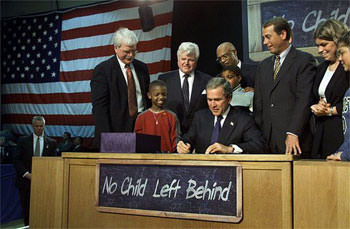Leaving Children Behind
The No Child Left Behind Act's relentless focus on testing blinds us to the egregious funding shortages that plague our nation's public schools.
Recently I was asked to join three others in a radio interview concerning the pros and cons of the No Child Left Behind debate. The others were temperate, balanced and guarded in their judgments. One, from the Fordham Institute, offered several intelligent insights and speculated that it is probably too soon to render an accurate assessment of the program’s efficacy. The other two interviewees were public school principals who, I believe, were trying to be fair and politically careful in not leveling any harsh criticisms. When asked by the moderator, Warren Olney, what’s good and what’s bad about the bill, both stated that it was good to design clear standards and to identify, by groups, who is and who isn’t measuring up. When addressing the “what’s bad” question, they suggested — rather guardedly, I thought — that perhaps not enough resources were being allotted to enable the schools to really succeed, and that some teachers may believe that the test narrows the curriculum too much and forces them to teach to the test.
In the face of all this politeness, I felt compelled to fire away with both barrels — as best I could, given the sound bites that radio compels one to issue. So, unlike the other three, I intemperately, unguardedly and one-sidedly made the following comments about No Child Left Behind (NCLB):
1. In fact, NCLB does force the teachers to teach to test; consequently it squeezes the joy out of teaching for both teacher and student.
2. It narrows the curriculum to math and reading because those are the areas tested. The arts, human development, physical education, community service, environmental education, field trips and other electives are given short shrift, at best.
3. Several teachers I have spoken with even say they are so depressed by the pressure and narrowness of the test that they are about to quit the field. In reality, I have yet to talk to one classroom teacher who has had anything positive to say about NCLB.
4. I will say quite boldly what one of the two principals only alluded to, namely, that public schools — particularly inner-city schools — are hugely underfunded. Overcrowded classes filled with non-English-speaking students, bereft of books and supplies, need dramatic increases in funds. In Los Angeles, for example, the per-pupil spending is $7,000-$8,000 per year; by contrast, quality private schools — which offer what public schools should but cannot provide — spend more than $25,000 per pupil. Unlimited billions for Iraq, but not enough for our children. But that is a rant from previous blogs — a rant I will no doubt continue to hurl into the tax-cuts void.
5. The real problem is that students are disengaged from their education, and disengaged students ultimately drop out, as more than 50 percent do in large urban and poor rural schools. The antidote to dropouts is a rich and diverse curriculum offered under improved teaching conditions.
6. If we really wanted to see that no child was left behind we would cut class sizes by half in inner-city schools, which would require hiring 100 percent more teachers in those schools, and we would obtain top-quality additional teachers by providing a pay increase of $25,000 a year across the board. If prison guards can make $75,000 to $100,000 a year, why can’t teachers? These changes would, of course, demand increased revenue that would, alas, require everyone — including wealthy individuals and corporations — to pay their fair share of taxes. Good luck!
So I say, fine, let’s test children periodically and let’s set high standards for our schools and our children. But beyond testing, let’s realize that diagnosis is just the beginning. To solve problems, you need to be willing to go the whole way down difficult roads, and to do this will require a far greater commitment than the federal government and civic leaders have given any indication they are willing to make. Our teachers and inner-city schools are facing overwhelming and heartbreaking odds, and we are letting them down.
Your support matters…Independent journalism is under threat and overshadowed by heavily funded mainstream media.
You can help level the playing field. Become a member.
Your tax-deductible contribution keeps us digging beneath the headlines to give you thought-provoking, investigative reporting and analysis that unearths what's really happening- without compromise.
Give today to support our courageous, independent journalists.






You need to be a supporter to comment.
There are currently no responses to this article.
Be the first to respond.